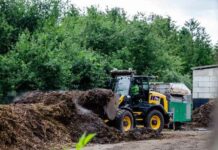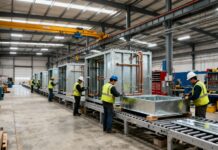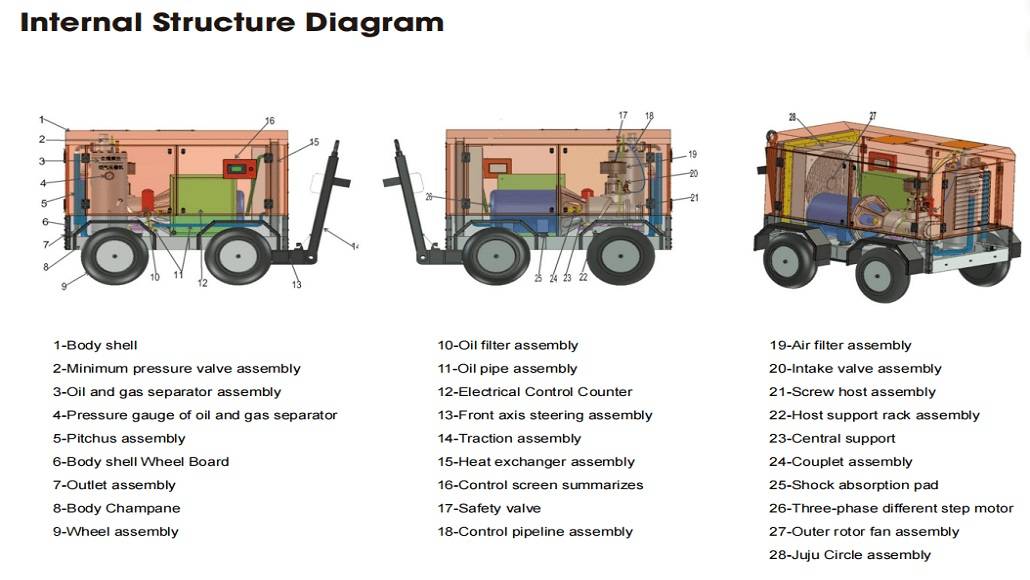Introduction
Using an air compressor powered by a diesel engine is the solution you opt-in when you require a high power compressor, unsurpassed portability, and rough-hewn performance in the absence of power grids. Portable diesel compressors are essential at constructing sites, mines, farms and road repair units, not mentioning the necessity of switching to external sources of electricity.
What is a Diesel Engine Air Compressor?
Compressing the atmospheric air can be achieved, when the diesel fuel is turned into mechanical energy by using an air compressor powered by diesel. The production of these units is normally:
- Pressure Range (PSI): 100 to 200 PSI
- Airflow Rate (CFM): 185-900 CFM (cubic feets per minute)
- Horsepower (HP): 40150 HP
- Fuel Type Diesel ( ULSD recommended)
This is the reason why they are ideal for worksites that are remote, mobile repair and heavy use of pneumatic tools.
Knowing the Portable Diesel Air Compressor
What makes a portable diesel air compressor special then? It is made so that it is mobile and comes with wheels or skids so that it is conveniently moved about.
Being able to move and withstanding impact are the secrets of their popularity. Majority of units include:
- Trailers that may be towed or frames mounted on skids
- Keeping the eye hooks up
- Fuel tanks (60-150 liters), which allows a 8-12 hours run time
- The popular machines such as Atlas Copco XAS 185 or Ingersoll Rand 7/41 may deliver 185 CFM at 100 PSI, which makes it a good choice before sandblasting or pneumatic drills.
Merits of Portable Diesel Air Compressor
The advantage of diesel powered air compressor over other types The anatomy of an air compressor is very simple, as it contains a system of conducting pressurized air at any given pressure. in a compressed form and air is taken into the body, which is released in a pressurized form.
1. Power Dependent free portability
No electricity point? No problem. You acquire on-the-move energy that is not dependent on an electric grid.
2. Heavy-Duty Construction
Designed using powerful steel frames, they work well between temperatures of -10 o c to 50 o c, rain or dust.
3. The Mileage and Durability
Diesel air compressors have runs longer per refuel such that their average consumption is 2.5 to 3.5 liter/hour.
Businesses which Depend on Diesel Air Compressors
- Construction: Running jackhammers and concrete vibrators, nail guns
- Mining: Drilling under-ground, blasting, ventilation
- Farming: Seed spraying, irrigation, air seeding
- Oil and Gas: Pressure testing Rig drilling and nitrogen generation
- Disaster Response: Emergency systems, clear roads: 10,000 Watts
Diesel Air Compressors vs Other Types
| Feature | Diesel Engine | Electric Motor | Petrol Engine |
| Portability | High | Low | Moderate |
| Fuel Cost (per liter) | $1.10 | N/A | $1.30 |
| CFM Range | 185–900 CFM | 20–150 CFM | 50–200 CFM |
| Runtime per Tank | 8–12 hours | Dependent on grid | 4–6 hours |
| Maintenance Frequency | Weekly checks | Monthly | Frequent |
| Noise Levels (dB) | 70–85 dB (with mufflers) | 60–70 dB | 85+ dB |
Key Use-Cases and Parameters
Sandblasting & Surface Prep
Air Demand 185-375 CFM
Working Pressure: 100 150 psi
Atlas Copco XATS 400 CD7 is recommended as a model.
Drilling & Hammering
250 500 CFM Air Demand:
Pressure: 125 200 PSI
Recommended Model: Doosan P425/ HP 375
Road Repairs
Accommodates more than one tool, like concrete cutters and tamper.
Cleaning Operations
Dust, metal shavings or paint surfaces are removed successfully with high-pressure air.
Why Construction Sites Prefer Diesel Models
- Long Running Times: No overhating and 12 Hours of continual playing
- Ruggedness: Act in gravel, heat and dust
- Multi-tool Capability: It can power 3-4 tools simultaneously because its CFM is sufficient.
Why Construction Sites Prefer Diesel Models
- CFM & PSI rating: Ability to perform according to the required tool rate
- Fuel Tank Dimension: 100+ litre of full shift capacity
- Noise Reduction: seek mufflers to maintain it at under 80 dB
- Safety Controls: Auto shut- off, overheat, oil warning
Tips to extended lifespan of use
No time set: Oil and coolant levels Weekly: Visible oil and coolant In Weekly: Visible oil and coolant, an inspection of the oil and coolant levels has to be conducted.
Monthly: Clean/Replace Air intake filters
Following Use: Drain off tank condensation
500 Hourly: Installed Overhauls: Change engine oil and fuel filters
Storage: Dry and dust-proof shed, preferably during winters
Environmental Considerations
Contemporary diesel compressors will have to fulfil the Tier 4 Final (USA) or Stage V (EU) emission standards. Characteristics to make it eco-friendly:
Particulate Filters
SCR Systems Selective Catalytic Reduction (SCR) Systems
Eco-mode (Idle on standby)
Conclusion
A portable diesel engine air compressor is not something you will use but need in the very mobile and power-thirsty industrial environment. Blasting roads, seeding farms or drilling mines this machine does what others can not. Select an appropriate model, follow a maintenance schedule, and your diesel compressor will be rewarding you in terms of years of untiring work.
FAQs
- What is the duration of a portable diesel air compressor on a single tank?
In most models, the run time takes approximately 8 to 12 hours depending on the size of the tank and engine loading.
- Which is superior, diesel or electricity in heavy-duty applications?
Yes, diesel models are more torquey, movable and high constancy yield, which is perfect in massive scale up exercises.
- What is its maintenance?
During driving, it is crucial to change and replace oil, filters, and drain the condensation. It is recommended to be serviced full at every 500 hours.
- Is it suitable to use indoors?
Use not to be recommended without the exhaust extraction systems as carbon monoxide gas is emitted.
- Which precautions should I take to be safe?
Look for air or fuel leaks
Use PPE (earplugs, gloves, boots)































